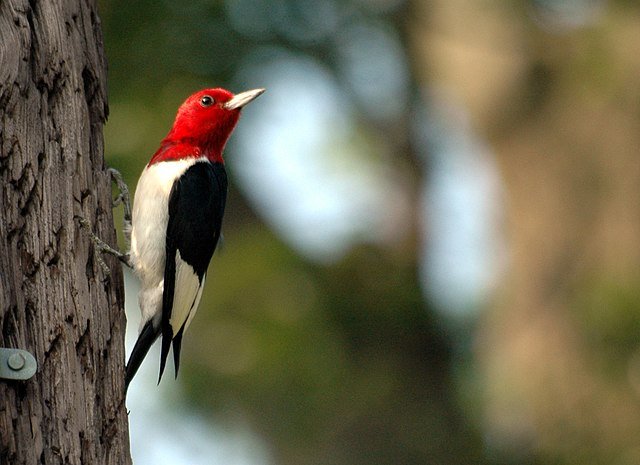March Nature Almanac: Marching to a Different Drummer
By Ruth Carol Cushman with Stephen Jones and Scott Severs
March 2023
It’s March! And different drummers are pounding on trees, metal railings, and the sides of our houses to proclaim that it’s spring. Flickers and other woodpeckers are beating out a fanfare—the noisier the better—hoping to ignite romance and deter rivals. No wonder woodpeckers were associated with Thor, the Norse god of thunder.
Male Downy Woodpecker. Photo by Gerhard Assenmacher.
Hairy and Downy Woodpeckers and Northern (red-shafted) Flickers (that often hybridize with eastern yellow-shafted flickers) are Boulder County’s most common members of the Picidae family. Other species you might be lucky enough to see here in Boulder County are Williamson’s Sapsucker, Red-naped Sapsucker, American Three-toed Woodpecker, and Lewis’s Woodpecker. This winter, birdwatchers have rejoiced because a couple of less common woodpeckers have been hanging out in a few choice spots around the county.
Female Red-bellied Woodpecker, showing a bit of the ever elusive, namesake red belly. Photo by Tom Friedel.
The Red-bellied Woodpecker, a common eastern and southern species, has been expanding its range northward along forested river bottoms in recent decades. One or two have been reported on eBird recently at Walden Ponds and along Boulder Creek on the Heatherwood Trail. Warmer winters and increasing numbers of bird feeders may help expedite this spread. In Colorado, there are only a few breeding records for the species, mainly in northeastern Colorado and none in Boulder County.
Like all woodpeckers, these omnivorous birds relish insects but also consume nuts, fruits, and seeds. They also will occasionally eat lizards and baby birds. Only four Colorado woodpecker species, including both the Red-bellied and the Red-headed, cache extra food for leaner times.
To attract a mate, the Red-bellied Woodpecker male calls and taps softly near the nest cavity he is excavating. Once the female accepts, she joins in the tapping and finishes the nest to her liking.
The name “red-bellied” is mostly misleading because the white belly has just a slight flush of red that is usually seen only when the bird is hanging upside down. Both males and females have handsome black and white checkered backs. The most noticeable feature, however, is a bright scarlet patch extending from the male’s forehead down the nape of his neck. The female’s red patch is not as extensive. Whoever named this bird probably couldn’t use that feature in choosing a name because an even more gorgeous bird already had claim to the name red-headed.
Red-headed Woodpecker. Photo courtesy of Dysmorodrepanis.
Red-headed Woodpeckers occur east of the Rocky Mountains across much of the US and southern Canada. In Colorado, they breed along stream corridors on the eastern plains, though there are also records from Boulder County. Red-headed Woodpeckers are more common than Red-bellied Woodpeckers in Boulder County. Once we even hosted one that came to the suet feeder in our yard. One or more have recently been reported along the Heatherwood Trail, as well as near the Sunset golf course in Longmont. Although they are now relatively rare in our county, they were listed as “fairly common” in historical records.
Sadly, their numbers are declining throughout North America as their preferred habitat of open, deciduous forests and large-diameter tree snags disappear. European Starlings have also been implicated in usurping their nest cavities.
Along with Lewis’s Woodpeckers, Red-headed Woodpeckers are among the few family members who catch insects in the air like flycatchers. According to Cornell’s All About Birds website, they cache insects and seeds in various crevices, such as under roof shingles and will even store grasshoppers alive, but wedged in so tightly they can’t escape. They are the only woodpecker known to cover their caches with wood or bark.
A snowy white body and inky black wings with white patches earned this flashy bird the nickname of “a flying checkerboard.” However, it’s the vivid crimson head on both male and female birds that makes you catch your breath in awe.
All members of the woodpecker family drill into trees for insects and nest in cavities. That’s why it’s important to leave some dead tree snags standing and to preserve our forest ecosystems.
Other March Events
Say’s Phoebes, Mountain Bluebirds, and Gray Catbirds have been reported recently in the county. Migrating Sandhill cranes will soon fly overhead.
Large flocks of Bohemian Waxwings are still being spotted in neighborhoods where dried fruit persists on the trees.
Early spring bloomers, such as Easter daisies and (a bit later) Bell’s twinpod, will soon bloom on shale outcroppings, such as those near Joder Ranch.
Chorus frogs will soon start to chirrup in the wetlands.
Hoary comma and mourning cloak butterflies will soon emerge.
A long, cold winter is melting into spring.



